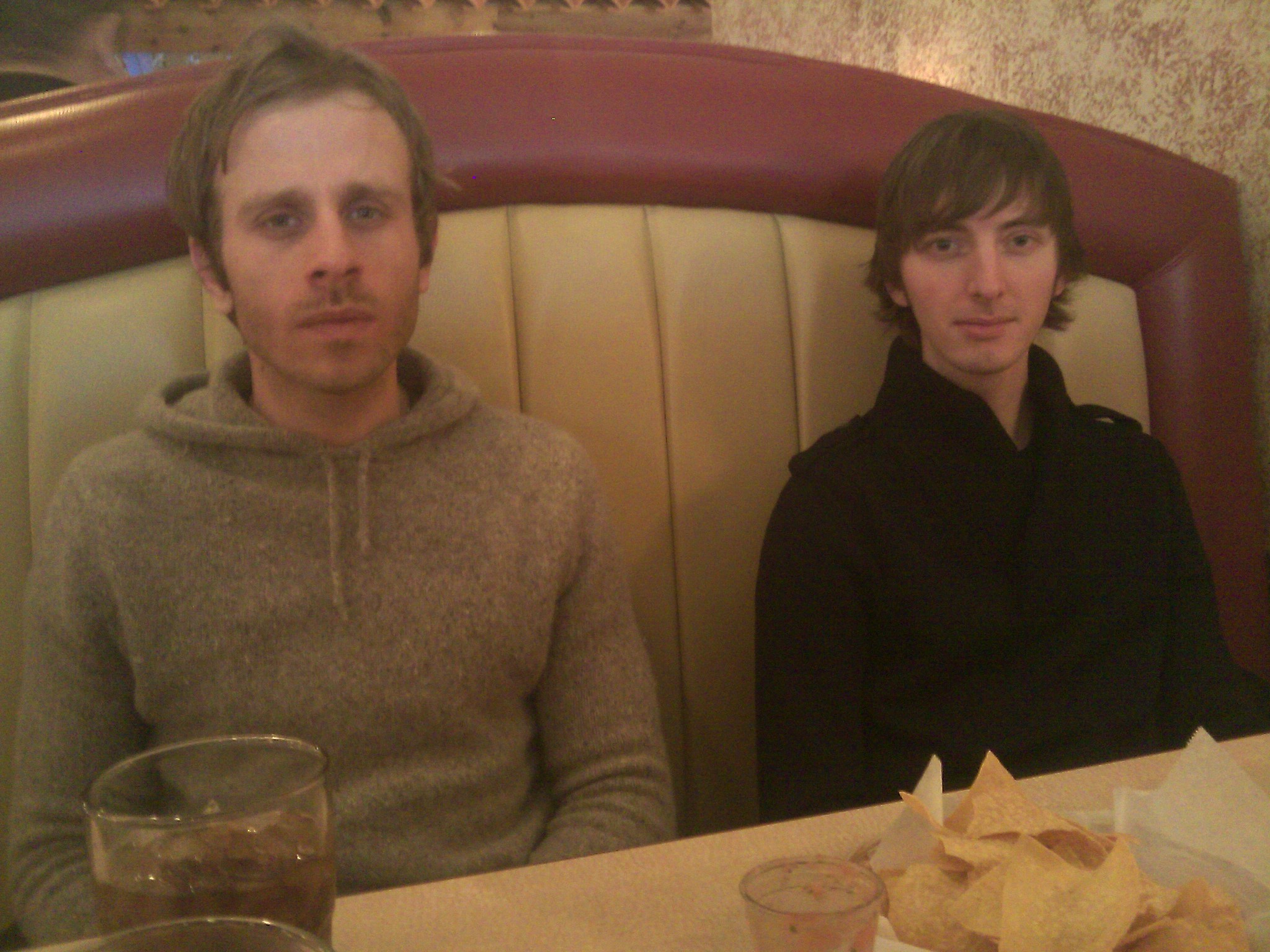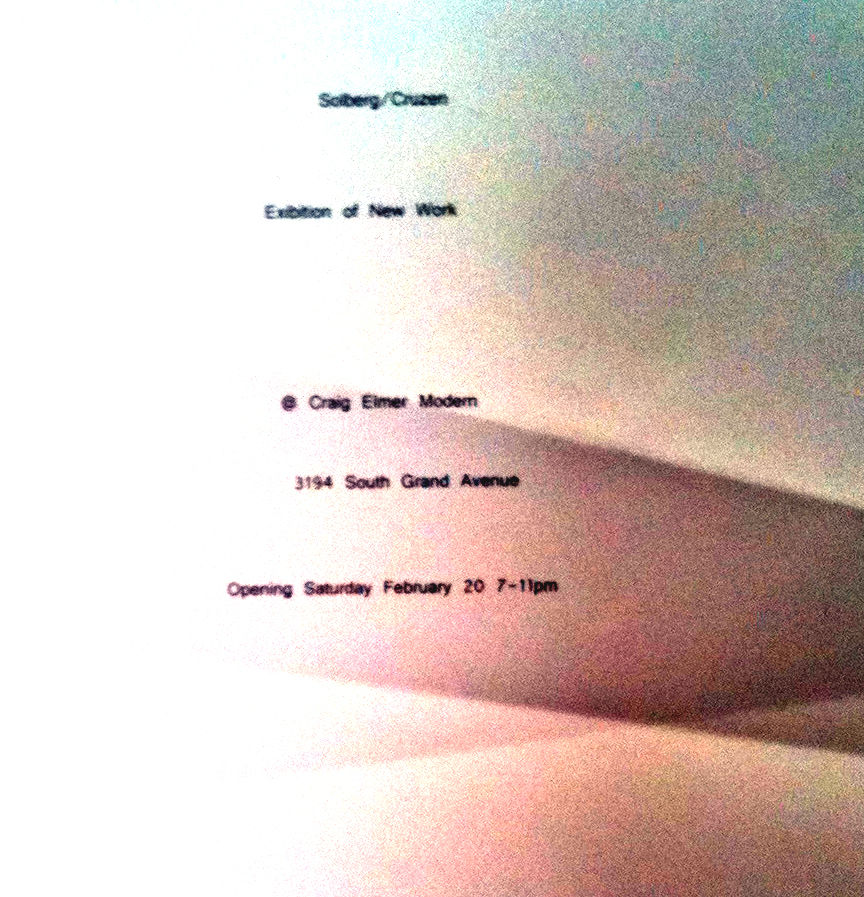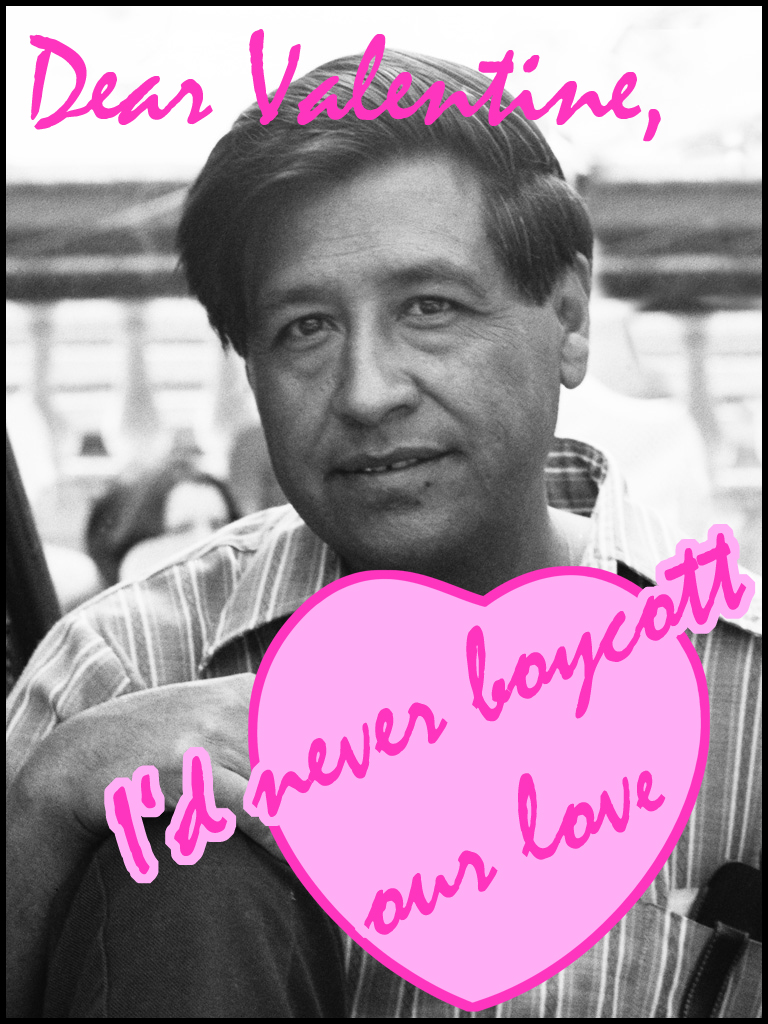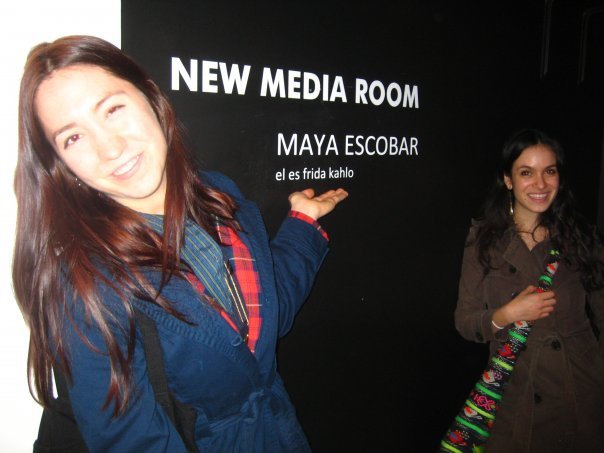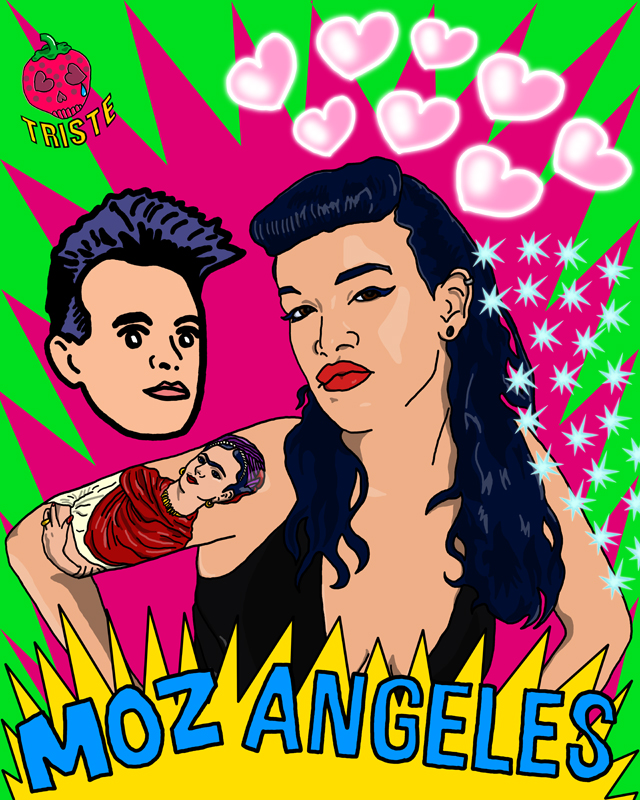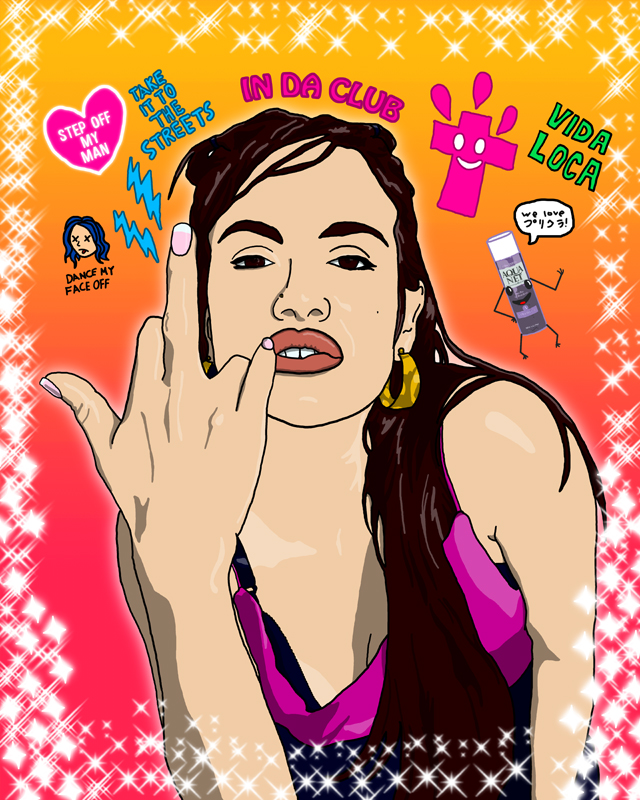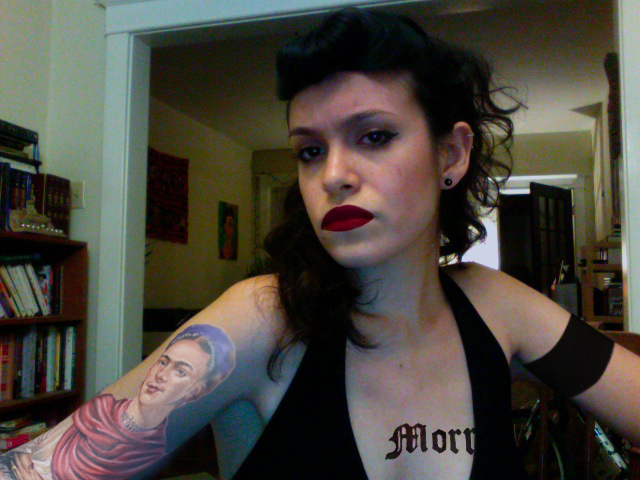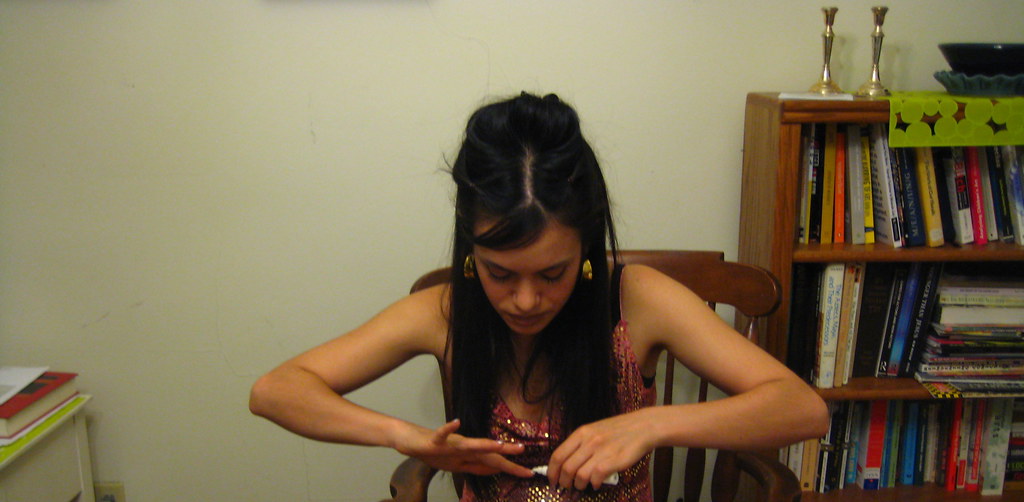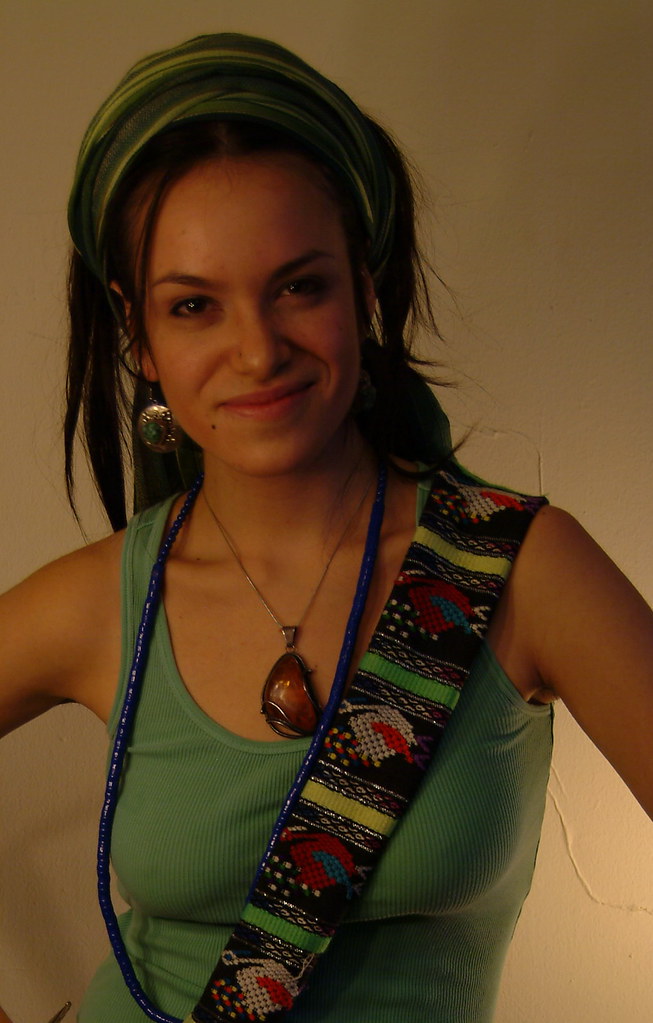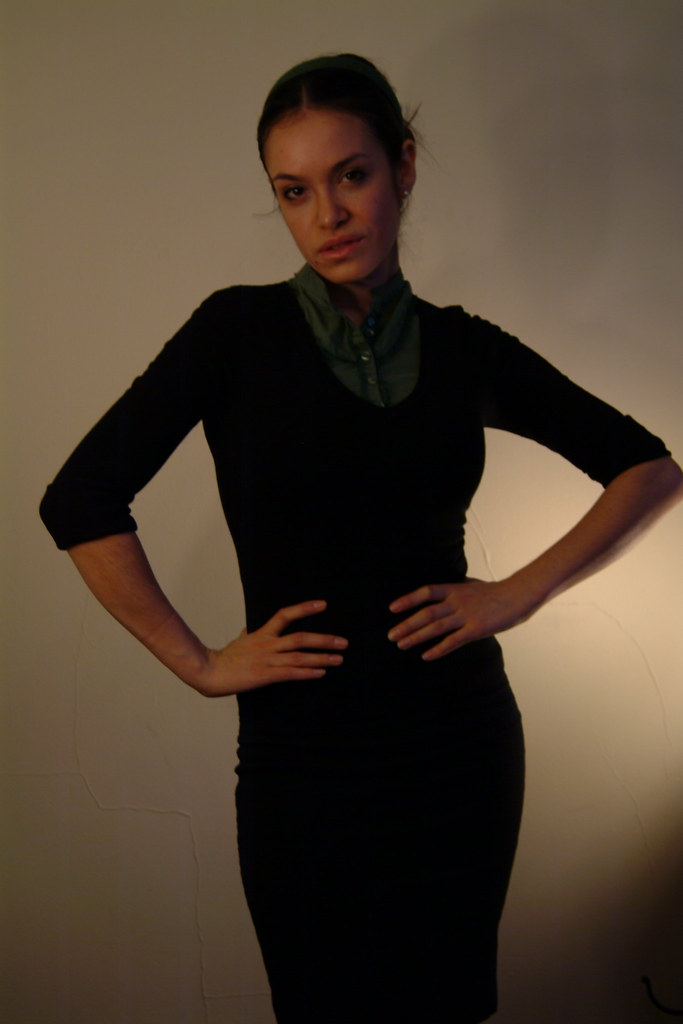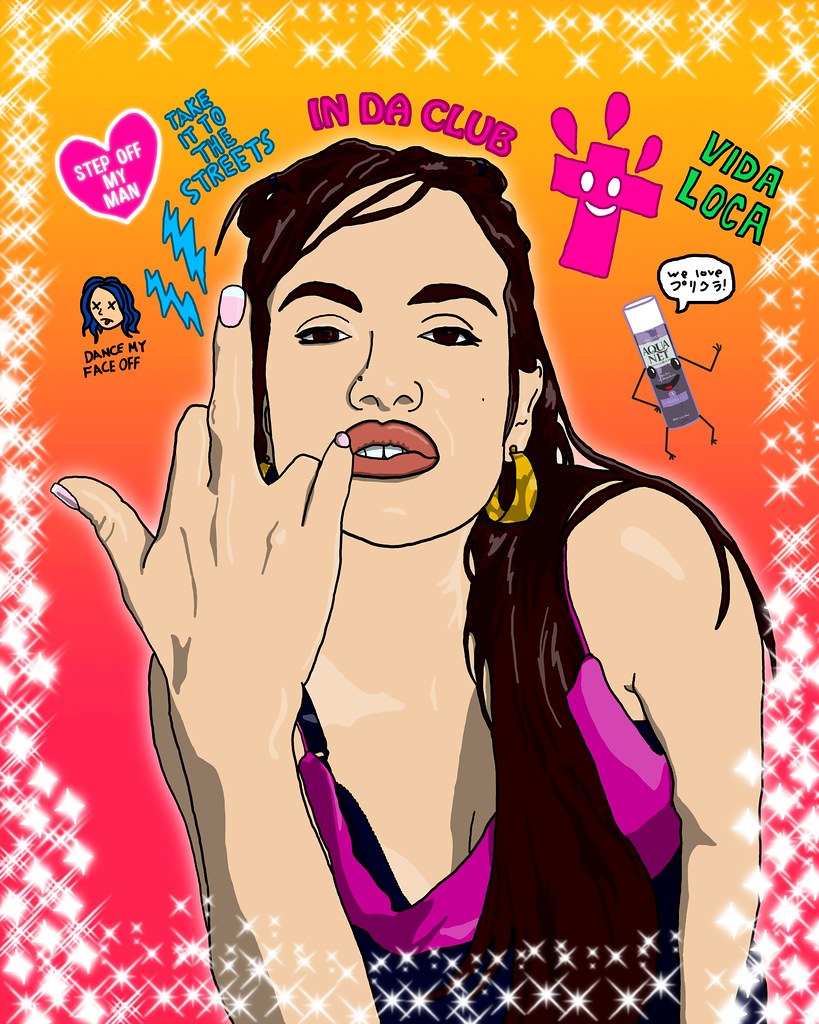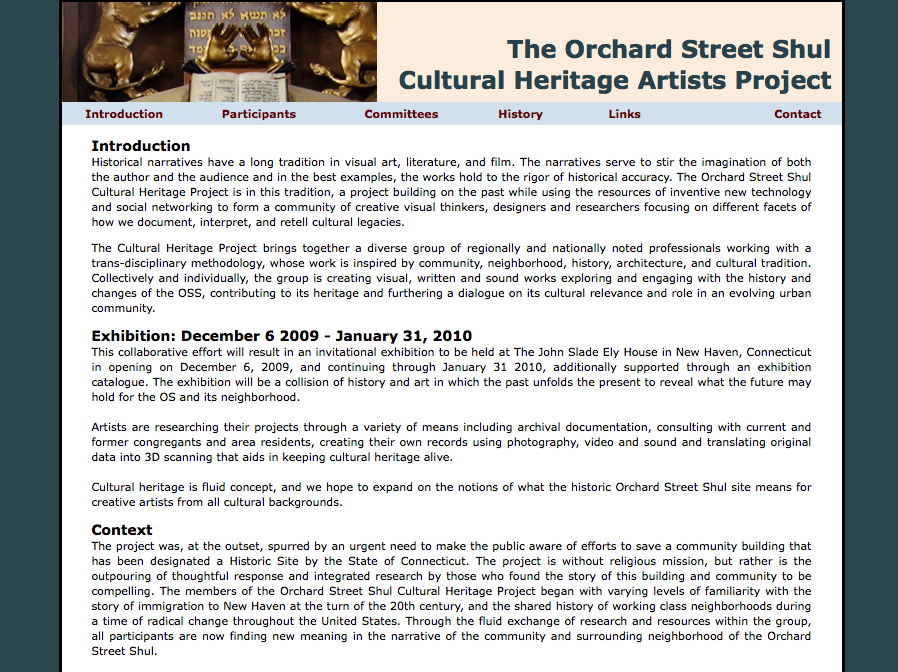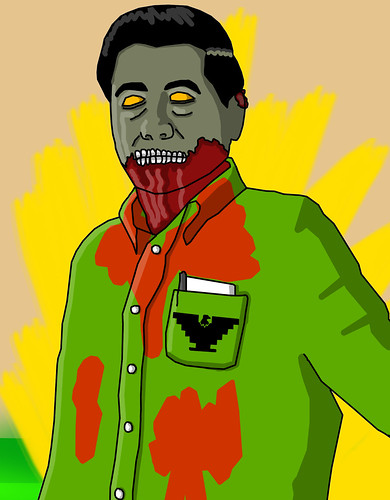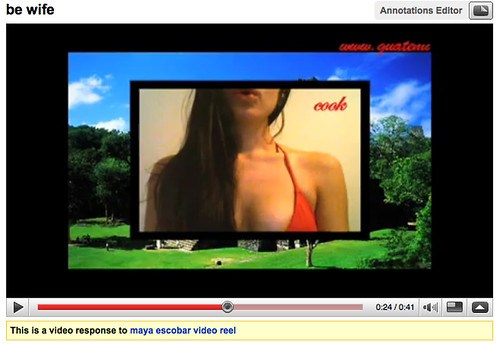ESCOBAR-MORALES: Resurrection of Hun-Nal-Ye at the Bruno David Gallery in St. Louis, MO. Opening on Friday, February 1, 2013, from 5 to 9 pm. Show runs until February 23rd, 2013.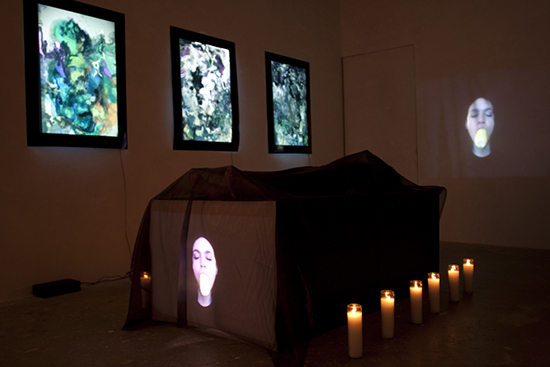 In the New Media Room, the Bruno David Gallery presents a single-channel video work titled “Resurrection of Hun-Nal-Ye” by Escobar-Morales. The 21-minutes video originated from a performance at the closing for RICH-OO-UH'L, RICH-OO-UH'L at Jolie Laide Gallery in Philadelphia, with sound by Armando Morales.In the Resurrection of Hun-Nal-Ye (2011), Escobar-Morales perform a funerary ritual, referencing the mythical Mayan tale of the Hero Twins reviving their dead father, the Maize God. In their contemporary interpretation of this ancient story, Escobar-Morales simultaneously represent the body and the soul; the God/ Goddess and twin offspring, in both physical and technological forms using live performance and web based video projection.ESCOBAR-MORALES is a team comprised of Maya Escobar and Andria Morales. The two artists, based in Chicago and New York respectively, have been working together over the Internet since 2010. They produce digital media and performance art that explores the role of self-representation in visual culture and its ability to deconstruct ingrained ideological conventions. By locating their performances online where they are free from restrictions of time and place, Escobar-Morales is able to concurrently enact multiple personas while simultaneously creating a unified hybrid self.Maya Escobar was born in Chicago, IL in 1984. Andria Morales was born in 1982 in New York, NY. Escobar received a BFA from the School of the Art Institute of Chicago (2007) and an MFA from Washington University in St. Louis (2009); Morales received a BA from the University of Pennsylvania (2004) and an MFA from Tyler School of Art, Temple University (2008).Photo by Armando Morales
In the New Media Room, the Bruno David Gallery presents a single-channel video work titled “Resurrection of Hun-Nal-Ye” by Escobar-Morales. The 21-minutes video originated from a performance at the closing for RICH-OO-UH'L, RICH-OO-UH'L at Jolie Laide Gallery in Philadelphia, with sound by Armando Morales.In the Resurrection of Hun-Nal-Ye (2011), Escobar-Morales perform a funerary ritual, referencing the mythical Mayan tale of the Hero Twins reviving their dead father, the Maize God. In their contemporary interpretation of this ancient story, Escobar-Morales simultaneously represent the body and the soul; the God/ Goddess and twin offspring, in both physical and technological forms using live performance and web based video projection.ESCOBAR-MORALES is a team comprised of Maya Escobar and Andria Morales. The two artists, based in Chicago and New York respectively, have been working together over the Internet since 2010. They produce digital media and performance art that explores the role of self-representation in visual culture and its ability to deconstruct ingrained ideological conventions. By locating their performances online where they are free from restrictions of time and place, Escobar-Morales is able to concurrently enact multiple personas while simultaneously creating a unified hybrid self.Maya Escobar was born in Chicago, IL in 1984. Andria Morales was born in 1982 in New York, NY. Escobar received a BFA from the School of the Art Institute of Chicago (2007) and an MFA from Washington University in St. Louis (2009); Morales received a BA from the University of Pennsylvania (2004) and an MFA from Tyler School of Art, Temple University (2008).Photo by Armando Morales
Escobar-Morales at The Painted Bride in Papeles: Are we what we sign?
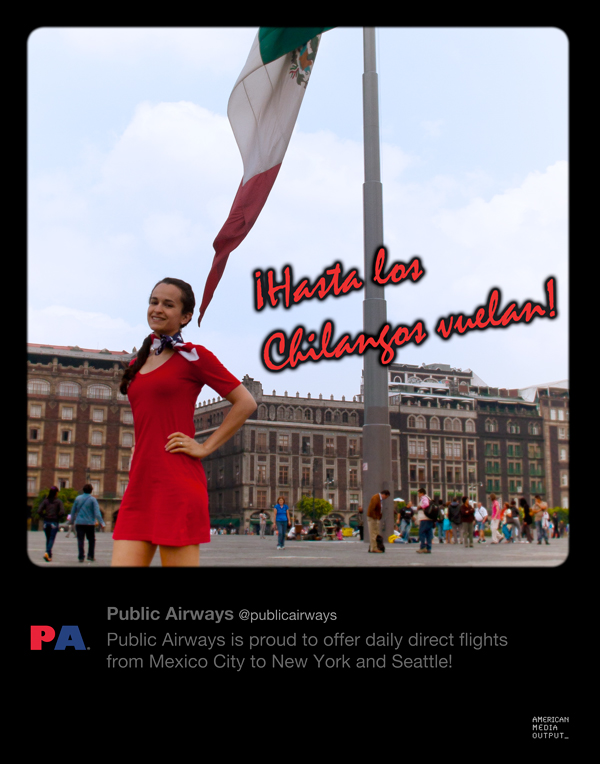 PAPELES: Are we what we sign? aims to serve as a visual examination of our social bond with papers as legal signifiers of identity that shape individual mobility, cultural acceptance, gender and sexual-orientation equality, economic access, labor opportunities, and educational attainment. Visual artists, community leaders, and arts administrators use this project to reflect upon the socio-cultural impact of documentation processes present in American society.This exhibition gathers twelve influential—established and emerging—artists working in drawing, painting, installation, printmaking, photography, and mixed media. Participating artists include Andrea Rincon, Andria Morales, Carlos Nuñez, Doris Nogueira-Rogers, Erika Ristovski, the duo Escobar-Morales, Jonas Dos Santos, Jorge Figueroa, Lina Cedeño, Michelle Ortiz, Paula Meninato, and Susana Amundaraín. They propose social-visual experiments from their positions as immigrants and/or descendants of immigrants from Latin American nations. New and existing works in this exhibition illuminate the concept of documentation into powerful narratives of critique, ambiguity, longing, and resilience.
PAPELES: Are we what we sign? aims to serve as a visual examination of our social bond with papers as legal signifiers of identity that shape individual mobility, cultural acceptance, gender and sexual-orientation equality, economic access, labor opportunities, and educational attainment. Visual artists, community leaders, and arts administrators use this project to reflect upon the socio-cultural impact of documentation processes present in American society.This exhibition gathers twelve influential—established and emerging—artists working in drawing, painting, installation, printmaking, photography, and mixed media. Participating artists include Andrea Rincon, Andria Morales, Carlos Nuñez, Doris Nogueira-Rogers, Erika Ristovski, the duo Escobar-Morales, Jonas Dos Santos, Jorge Figueroa, Lina Cedeño, Michelle Ortiz, Paula Meninato, and Susana Amundaraín. They propose social-visual experiments from their positions as immigrants and/or descendants of immigrants from Latin American nations. New and existing works in this exhibition illuminate the concept of documentation into powerful narratives of critique, ambiguity, longing, and resilience.  The Painted Bride230 Vine Street | Philadelphia, PA 19106 | 215.925.9914September 7 – October 21, 2012Gallery hours: 12pm – 6pm, Tues – SatFirst Friday receptions: September 7, October 5 | 5-7:30pmGuest Curator Andreina Castillo | Co-Presented with Acción Colombia
The Painted Bride230 Vine Street | Philadelphia, PA 19106 | 215.925.9914September 7 – October 21, 2012Gallery hours: 12pm – 6pm, Tues – SatFirst Friday receptions: September 7, October 5 | 5-7:30pmGuest Curator Andreina Castillo | Co-Presented with Acción Colombia
AMerican MEdia Output in Texas
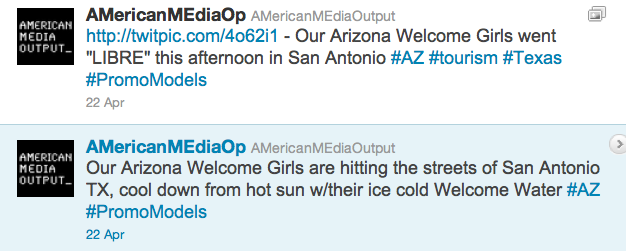 [youtube=http://youtu.be/CMDhowuCwDE]AMericanMEdiaOutput.com
[youtube=http://youtu.be/CMDhowuCwDE]AMericanMEdiaOutput.com![]()
![]()
![]()
Escobar-Morales
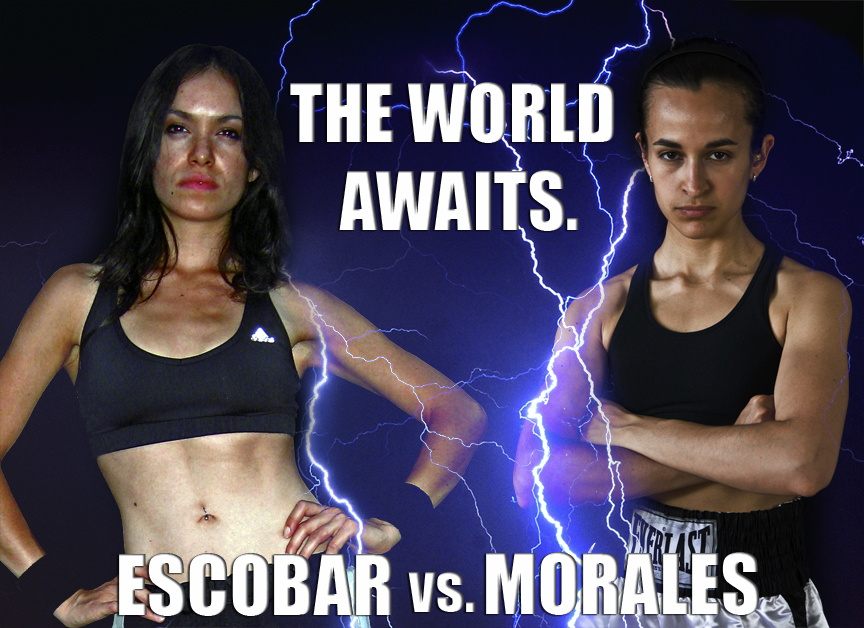 Artist Statement and BioEscobar-Morales is a team comprised of Maya Escobar and Andria Morales. The two artists, based in Chicago and Philadelphia respectively, have been working together over the Internet since 2010. They produce digital media and performance art that explores the role of self-representation in visual culture and its ability to deconstruct ingrained ideological conventions. By locating their performances online where they are free from restrictions of time and place, Escobar-Morales is able to concurrently enact multiple personas while simultaneously creating a unified hybrid self.Maya Escobar was born in Chicago, IL in 1984. Andria Morales was born in 1982 in New York, NY. Escobar received a BFA from the School of the Art Institue of Chicago (2007) and an MFA from Washington University in St. Louis (2009); Morales received a BA from the University of Pennsylvania (2004) and an MFA from Tyler School of Art, Temple University (2008).
Artist Statement and BioEscobar-Morales is a team comprised of Maya Escobar and Andria Morales. The two artists, based in Chicago and Philadelphia respectively, have been working together over the Internet since 2010. They produce digital media and performance art that explores the role of self-representation in visual culture and its ability to deconstruct ingrained ideological conventions. By locating their performances online where they are free from restrictions of time and place, Escobar-Morales is able to concurrently enact multiple personas while simultaneously creating a unified hybrid self.Maya Escobar was born in Chicago, IL in 1984. Andria Morales was born in 1982 in New York, NY. Escobar received a BFA from the School of the Art Institue of Chicago (2007) and an MFA from Washington University in St. Louis (2009); Morales received a BA from the University of Pennsylvania (2004) and an MFA from Tyler School of Art, Temple University (2008).
Ian Weaver, The Black Knights of the Black Bottom, and Are You My Other?
On the afternoon of November 18, 2010, on the Island of Facebook, history was made... in response to the Fat Free Elotera post:Ian Weaver: I take ALL the credit for this (and future) collaborations between these two exceptional artists....! [just needed to make sure I put in that legal boilerplate stuff, just a formality]Andria Morales: No doubt! We are eternally grateful to the prolific genius of Ian Weaver for the inspired notion of pairing us together.Maya Escobar: YES!!! So true- we are Are You My Other? because of this Fine Man. We keep trying to figure out just how to pay homage... Latina Black Bottom promo girls? Just saying :)Ian Weaver: By commenting on my post you have in effect given me the legal authority to profit in part from any future performances, lectures, presentations, and sales of related merchandise. I will work out the percentages later with my BB lawyer, but for conversation sake, let's just say if you perform jointly at, say, the Mattress Factory or the Renaissance Society that I will net 33.33% of profits from said performance.Again, I will get my BB lawyer to draw up the papersAndria Morales: Did we just get served??? So much for the We ♥ BB Knights campaign...Ian Weaver: Nooooo! You haven't been served! I can't do that online; you will be formally served in person presently (I think someone is at your door; delivery guy??? Flowers By Irene???)Maya Escobar: I think a cut of all "BB profits" is totally fair and should be required.. LOL.. "profit" what an interesting concept... "to make money from art"... am I dreaming? But hey Ian if you can work us in to an of the aforementioned "performances, lectures, presentations, and sales of related merchandise" and oh "performances at, say, the Mattress Factory or the Renaissance Society" Are You My Other? would be eternally grateful.Ian Weaver: Done! I am on the phone with Hamza was we speak. I will work the Pittsburgh angle after the holidays.And seriously, fantastic work by both of you! I got on the blog; really interesting! I am having Maya present in my spring Research class for artists, and if I had the dough I would fly you out Andria and have you guys co-present. But, that would blow my transfer student's minds!Andria Morales: I think Maya and I meeting each other in person would blow OUR minds. Lets start a fundraiser!Maya Escobar: Wow, wow, wow!!! Is it okay with the two of you if I screen-shot this convo and re-post? Ian, I am going to try to see if there are any opps to lecture in other SAIC departments that week so that we could get funding for Andria to come in.Andria Morales: Summon your internet powersIan Weaver: GO FOR IT! I AM OPEN TO IT!!
in response to the Fat Free Elotera post:Ian Weaver: I take ALL the credit for this (and future) collaborations between these two exceptional artists....! [just needed to make sure I put in that legal boilerplate stuff, just a formality]Andria Morales: No doubt! We are eternally grateful to the prolific genius of Ian Weaver for the inspired notion of pairing us together.Maya Escobar: YES!!! So true- we are Are You My Other? because of this Fine Man. We keep trying to figure out just how to pay homage... Latina Black Bottom promo girls? Just saying :)Ian Weaver: By commenting on my post you have in effect given me the legal authority to profit in part from any future performances, lectures, presentations, and sales of related merchandise. I will work out the percentages later with my BB lawyer, but for conversation sake, let's just say if you perform jointly at, say, the Mattress Factory or the Renaissance Society that I will net 33.33% of profits from said performance.Again, I will get my BB lawyer to draw up the papersAndria Morales: Did we just get served??? So much for the We ♥ BB Knights campaign...Ian Weaver: Nooooo! You haven't been served! I can't do that online; you will be formally served in person presently (I think someone is at your door; delivery guy??? Flowers By Irene???)Maya Escobar: I think a cut of all "BB profits" is totally fair and should be required.. LOL.. "profit" what an interesting concept... "to make money from art"... am I dreaming? But hey Ian if you can work us in to an of the aforementioned "performances, lectures, presentations, and sales of related merchandise" and oh "performances at, say, the Mattress Factory or the Renaissance Society" Are You My Other? would be eternally grateful.Ian Weaver: Done! I am on the phone with Hamza was we speak. I will work the Pittsburgh angle after the holidays.And seriously, fantastic work by both of you! I got on the blog; really interesting! I am having Maya present in my spring Research class for artists, and if I had the dough I would fly you out Andria and have you guys co-present. But, that would blow my transfer student's minds!Andria Morales: I think Maya and I meeting each other in person would blow OUR minds. Lets start a fundraiser!Maya Escobar: Wow, wow, wow!!! Is it okay with the two of you if I screen-shot this convo and re-post? Ian, I am going to try to see if there are any opps to lecture in other SAIC departments that week so that we could get funding for Andria to come in.Andria Morales: Summon your internet powersIan Weaver: GO FOR IT! I AM OPEN TO IT!!
Emerging Paradigms in Critical Mixed Race Studies
 Come join me at the 1st annual Critical Mixed Race Studies Conference, Emerging Paradigms in Critical Mixed Race Studies, at DePaul University in Chicago, November 5-6, 2010.
Come join me at the 1st annual Critical Mixed Race Studies Conference, Emerging Paradigms in Critical Mixed Race Studies, at DePaul University in Chicago, November 5-6, 2010.
The CMRS conference brings together scholars from a variety of disciplines nationwide. Recognizing that the diverse disciplines that have nurtured Mixed Race Studies have reached a watershed moment, the 2010 CMRS conference is devoted to the general theme “Emerging Paradigms in Critical Mixed Race Studies.”Critical Mixed Race Studies (CMRS) is the transracial, transdisciplinary, and transnational critical analysis of the institutionalization of social, cultural, and political orders based on dominant conceptions of race. CMRS emphasizes the mutability of race and the porosity of racial boundaries in order to critique processes of racialization and social stratification based on race. CMRS addresses local and global systemic injustices rooted in systems of racialization.
I will be presenting at the conference on November 5th in a roundtable discussion moderated by Laura Kina, on the use of arts in challenging racial ideologies. My next post will include more information on the roundtable and on my fellow panelists: Alejandro T. Acierto, Tina Ramirez, and Jonathan Reinert.
Solberg/Cruzen at the Craig Elmer Modern
The Boys at Mi Ranchito, 2010
Jacob Cruzen and Dan Solberg are taking Saint Louis by storm with their exhibition Solberg/Cruzen, opening tomorrow night at the Craig Elmer Modern. Solberg/Cruzen promises to be filled with positivity, mysticism, and finely crafted objects.
Solberg/Cruzen Exhibition of New WorkFebruary 20th - March 20thCraig Elmer Modern3194 South GrandSt Louis, MO 63116
belated valentines day love from el rio
Sorry for the delay in this post. I have been in Chicago tied up with CAA, so much so, that the lovely Hallmark holiday of love, almost slipped through my fingers. But have no fear, I am back with full force, presenting my now frequent colllaborator Rio Yañez's pop culture, commodified, chicano, arty valentines amazingness.
From his El Rio flickr page:
What’s up to all my friends, lovers, and drunken makeout partners! El Rio’s Valentine’s Day Cards are back in the ring to take another swing for 2010! This is the 4th year of my cards and it's turned into my longest running project. Enjoy!
As always, please post these cards on the pages of your friends, enemies, sexting partners, craigslist hookups, and friends with benefits.
Stimulus, 2010
Sotomayor, 2010
Supa Freaks, 2008
El Rio's Valentine's Day Cards # 2, 2007
Moz Lov, 2009
el es frida kahlo at the gallery
el es frida kahlo is currently on view in the New Media Room at the Bruno David Gallery in St. Louis, MO.
el es frida kahlo, 2007-present
Frida Kahlo played with the identity that she wanted to project and the identity that was placed on her by others. Kahlo used her clothing, political affiliations, sexual escapades, and personal traumas, to create a character that informed her body of work. She inscribed her identity, painting her image over and over, constructing a mythology around her persona.
In el es frida kahlo I confront the ambivalence I experience as a result of my simultaneous obsession with Frida Kahlo and weariness towards her commodification. Viewed from a tiny pinhole, dressed as Kahlo, I stand before a reproduction of one of her self portraits. With a mixture of rage, anxiety, and complete fear, I chant “el es Frida Kahlo, ella es Frida Kahlo, el es Frida Kahlo, yo soy, yo soy, yo soy Frida Kahlo,” he is Frida Kahlo, she is Frida Kahlo, I am, I am, I am Frida Kahlo. As I yell, the painting behind me begins to fall. I violently tear down my braids and smudge off my makeup while continuing to scream “I am Frida Kahlo, I am Frida Kahlo, yo soy Frida Kahlo!”
[youtube=http://www.youtube.com/watch?v=0BJmaYn5IIE]
el es frida kahlo at the Bruno David Gallery (video filmed and edited by Felicia Chen)
[youtube=http://www.youtube.com/watch?v=xlMPoFXRT18]
el es frida kahlo YouTube video
FREE el es frida kahlo animated gif avaliable on MayaEscobar.com
link to translation of recent review by David Sperber in Ma’arav Israeli Arts and Culture Magazine:
Frida Kahlo at the synagogue: Maya Escobar and the young Jewish-American Creation
behind the scenes acciones plásticas purikura
Here are some behind the scenes images from the many Acciones Plásticas プリクラ photo shoots.
The Latina Hipster
The Homegirl
The Homegirl putting on fake nails (lovin' the shabbos candlesticks and theory books in the background)
The Avodah Girl
The 612er
---------------------------------------------------------
Check out this inspiring write-up on Acciones Plásticas プリクラ on Truth and Healing Project.excerpt below:
goodness. I’ve been thinking a lot about the intersections between new media and traditional forms of knowledge and how these intersections can be ways of supporting tradition, innovation, resistance and liberation. As a media-maker, I’ve thought a lot about non-traditional forms of telling stories and the value of stories to allow us as individuals and communities to grow and remain in movement. I want to both honor our traditions and create space for challenge in order to support growth. This is particularly challenging when, as indigenos, we are usually FORCED into the frozen stance (as my sister Whisper says) of the “American Imaginary”. Born out of a flat analysis, the “American Imaginary” boxes us into specific archetypes and narratives that, though perhaps grounded in truth, metaphorically and at times literally “freeze” us and immobilize us from engaging in healthy movement and LIFE. As a guatemalan-born/ mixed -id’d/ mayan-adoptee I’ve dreamed about new and innovative ways to create forums and craft form that embodies the intersections of say, mayan id, transracial queer, working class, single teen mama id. For example, as a queerasfuck femme I’ve LITERALLY dreamed of beginning a series of corsets created out of huipil’s with stories attached to each… though I have yet to begin work on that. I am so excited by the thoughts of spaces for dialogue, beauty, challenge & examination of the COMPLEX identities embodies by the our contemporary indigena communities. . Fierce and phenomenal chicana and radical latina artists have had HUGE impacts on me but I’ve been hungry to see this come from other guatemelan/ mayan artists. Today, I got a taste of a contemporary and GUATEMALAN artist who is actively engaged in a similar examination! I came across this blog (and art work) and it was as if an answer was given to me in the form of possibilities. A sweet affirmation that this form of mayan/guatemalan art CAN and DOES exist.
Tzit Tzit: Fiber Art and Jewish Identity
I met Ben Schachter at the 2009 Conney Conference on Jewish Art: Performing Histories, Inscribing Jewishness, where coincidentally, we both presented Eruv themed works.In addition to making humorous Jewish themed conceptual art, Ben is a curator and is the man behind Tzit Tzit: Fiber Art and Jewish Identity. I have a few pieces from Hiddur Mitzvah included in the show.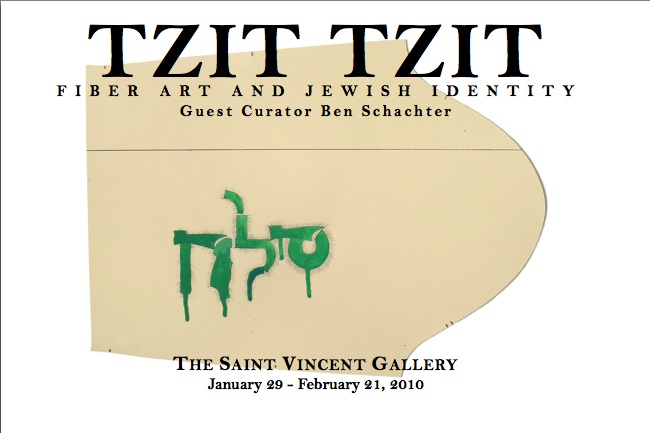 A special exhibit assembled by guest curator Ben Schachter, “Tzit Tzit: Fiber Art and Jewish Identity,” will open with a reception at The Saint Vincent Gallery in the Robert S. Carey Student Center at Saint Vincent College from 6 to 8:30 p.m. Thursday, January 28. Admission is free and open to the public.The exhibit will continue from Friday, January 29 through Sunday, February 21 during regular Gallery hours: 12 noon to 3 p.m. and 6:30 to 8:30 p.m. Tuesdays, Wednesdays and Thursdays; 12 noon to 3 p.m. Fridays, Saturdays and Sundays. The Gallery is closed on Mondays.Participating artists include Maya Escobar, Melanie Dankowicz, Carol Es, Leslie Golomb, Louise Silk and Shirah Apple.Ms. Silk will present a lecture, “Quilting and Spirituality,” at 6 p.m. Monday, February 9 in room 100 of Prep Hall.Mr. Schachter, associate professor of fine arts, will give a Gallery tour of the exhibition at 7:30 p.m. Tuesday, February 9.The exhibit was developed by Mr. Schachter. “I have been studying various aspects of Jewish art for the past three years and this exhibit is an outgrowth of that interest,” Mr. Schachter said. “The artists hail from Los Angeles, New York City, Kansas City, Illinois and Pittsburgh.”“Fiber art refers to any use of a cloth such as stitching or weaving,” he explained. “The title, Tzit Tzit, refers to the fringe on a prayer shawl, or tallis, worn by many Jews during prayer. While using thread, cloth, pattern making, stitching and other craft materials, each artists’ process creates a language derived from craft techniques that reinterprets the Old Testament, the oral law as written in the Talmud and personal histories. In so doing, both craft theory and Jewish Art are reinvigorated. I learned of these artists through Jewish art conferences I have attended, through exhibitions and through national awards. I think our students and our friends in the region will really enjoy seeing their work.”Ben Schachter is an artist whose work integrates conceptual art and Jewish law. He sees a connection between the rules artists have created to guide and limit their work and Jewish traditions. His work has been shown nationally and will be on exhibition at the Westmoreland Museum of Art in Greensburg concurrent with this exhibition. He holds an M.F.A. and M.S. degree from Pratt Institute and lives in Pittsburgh with his wife and two children.Carol Es paints images that powerfully scream of a life of hard labor. As a child she worked endless hours in a sweatshop with her family. Ms. Es' works are featured in numerous private and public collections, including the Getty Museum, Brooklyn Museum, UCLA Special Collections, the Jaffe Collection and Centre Georges Pompidou in Paris. She is also a two-time recipient of the ARC Grant from the Durfee Foundation and was recently awarded the prestigious Pollock-Krasner Fellowship.Maya Escobar’s work directly challenges gender roles and illustrates how Jewish tradition empowers women. Ms. Escobar received her master of fine arts degree from the Sam Fox School of Design & Visual Arts, Washington University in St. Louis, and her bachelor of fine arts degree from the School of the Art Institute of Chicago. She has exhibited work in Spain, Guatemala, United States, Germany and Venezuela.Melanie Dankowicz creates intricate papercut sculptures, marriage contracts, and wall art. An expansion of the medium, Dankowicz's three-dimensional forms are ephemeral lace-like paper structures, of elegant tracery that has inspired her recent metalwork. She draws inspiration from the countryside of Illinois, where she resides with Harry and their three children.Leslie Golomb exhibits her work nationally and internationally and is the recipient of numerous awards, including recognition from the National Endowment for the Arts, Pennsylvania Council on the Arts Individual Artists Fellowship Award and a State of the Art Award from the State Museum of Pennsylvania. Her work was recently included in the Three Rivers Arts Festival and Best of Pittsburgh Invitational. Ms. Golomb holds a bachelor in fine arts from Carnegie-Mellon University and a master of fine arts from the School of the Art Institute of Chicago. She served as founder and director of the American Jewish Museum of the Jewish Community Center of Greater Pittsburgh for nine years. She has returned to the studio producing prints and artists books.Louise Silk began her quest to acquire skills as a quilter after being inspired by an article in Ms. Magazine in 1971 about quilt making as a woman's art form. Over the past 30 years, her work has been included in Quilt National Biennial Exhibition of Contemporary Quilts as well as many private corporate collections such as USAirways, Paine Webber and PNC Bank. She is a certified Integrated Kabbalistic Healer. She is currently living and working from her loft in the South Side of Pittsburgh, Pennsylvania.Ms. Golumb and Ms. Silk collaborate and join their printmaking and fiber art into multilayered quilts, runners and tallisim. The images and techniques bring together American folk traditions and Jewish history in surprising ways. Ultimately the perspective of these five artists reinvigorates what Jewish Art is and can become.Shirah Apple received a master of fine arts degree from the Rinehart School of Sculpture at the Maryland Institute College of Art in 2006. She is a graduate of MICA’s post-baccalaureate certificate program and of Miami University, where she received a bachelor of science degree in business administration.Further information about the exhibition is available by contacting the Gallery at 724 805-2107, www.stvincent.edu/gallery.
A special exhibit assembled by guest curator Ben Schachter, “Tzit Tzit: Fiber Art and Jewish Identity,” will open with a reception at The Saint Vincent Gallery in the Robert S. Carey Student Center at Saint Vincent College from 6 to 8:30 p.m. Thursday, January 28. Admission is free and open to the public.The exhibit will continue from Friday, January 29 through Sunday, February 21 during regular Gallery hours: 12 noon to 3 p.m. and 6:30 to 8:30 p.m. Tuesdays, Wednesdays and Thursdays; 12 noon to 3 p.m. Fridays, Saturdays and Sundays. The Gallery is closed on Mondays.Participating artists include Maya Escobar, Melanie Dankowicz, Carol Es, Leslie Golomb, Louise Silk and Shirah Apple.Ms. Silk will present a lecture, “Quilting and Spirituality,” at 6 p.m. Monday, February 9 in room 100 of Prep Hall.Mr. Schachter, associate professor of fine arts, will give a Gallery tour of the exhibition at 7:30 p.m. Tuesday, February 9.The exhibit was developed by Mr. Schachter. “I have been studying various aspects of Jewish art for the past three years and this exhibit is an outgrowth of that interest,” Mr. Schachter said. “The artists hail from Los Angeles, New York City, Kansas City, Illinois and Pittsburgh.”“Fiber art refers to any use of a cloth such as stitching or weaving,” he explained. “The title, Tzit Tzit, refers to the fringe on a prayer shawl, or tallis, worn by many Jews during prayer. While using thread, cloth, pattern making, stitching and other craft materials, each artists’ process creates a language derived from craft techniques that reinterprets the Old Testament, the oral law as written in the Talmud and personal histories. In so doing, both craft theory and Jewish Art are reinvigorated. I learned of these artists through Jewish art conferences I have attended, through exhibitions and through national awards. I think our students and our friends in the region will really enjoy seeing their work.”Ben Schachter is an artist whose work integrates conceptual art and Jewish law. He sees a connection between the rules artists have created to guide and limit their work and Jewish traditions. His work has been shown nationally and will be on exhibition at the Westmoreland Museum of Art in Greensburg concurrent with this exhibition. He holds an M.F.A. and M.S. degree from Pratt Institute and lives in Pittsburgh with his wife and two children.Carol Es paints images that powerfully scream of a life of hard labor. As a child she worked endless hours in a sweatshop with her family. Ms. Es' works are featured in numerous private and public collections, including the Getty Museum, Brooklyn Museum, UCLA Special Collections, the Jaffe Collection and Centre Georges Pompidou in Paris. She is also a two-time recipient of the ARC Grant from the Durfee Foundation and was recently awarded the prestigious Pollock-Krasner Fellowship.Maya Escobar’s work directly challenges gender roles and illustrates how Jewish tradition empowers women. Ms. Escobar received her master of fine arts degree from the Sam Fox School of Design & Visual Arts, Washington University in St. Louis, and her bachelor of fine arts degree from the School of the Art Institute of Chicago. She has exhibited work in Spain, Guatemala, United States, Germany and Venezuela.Melanie Dankowicz creates intricate papercut sculptures, marriage contracts, and wall art. An expansion of the medium, Dankowicz's three-dimensional forms are ephemeral lace-like paper structures, of elegant tracery that has inspired her recent metalwork. She draws inspiration from the countryside of Illinois, where she resides with Harry and their three children.Leslie Golomb exhibits her work nationally and internationally and is the recipient of numerous awards, including recognition from the National Endowment for the Arts, Pennsylvania Council on the Arts Individual Artists Fellowship Award and a State of the Art Award from the State Museum of Pennsylvania. Her work was recently included in the Three Rivers Arts Festival and Best of Pittsburgh Invitational. Ms. Golomb holds a bachelor in fine arts from Carnegie-Mellon University and a master of fine arts from the School of the Art Institute of Chicago. She served as founder and director of the American Jewish Museum of the Jewish Community Center of Greater Pittsburgh for nine years. She has returned to the studio producing prints and artists books.Louise Silk began her quest to acquire skills as a quilter after being inspired by an article in Ms. Magazine in 1971 about quilt making as a woman's art form. Over the past 30 years, her work has been included in Quilt National Biennial Exhibition of Contemporary Quilts as well as many private corporate collections such as USAirways, Paine Webber and PNC Bank. She is a certified Integrated Kabbalistic Healer. She is currently living and working from her loft in the South Side of Pittsburgh, Pennsylvania.Ms. Golumb and Ms. Silk collaborate and join their printmaking and fiber art into multilayered quilts, runners and tallisim. The images and techniques bring together American folk traditions and Jewish history in surprising ways. Ultimately the perspective of these five artists reinvigorates what Jewish Art is and can become.Shirah Apple received a master of fine arts degree from the Rinehart School of Sculpture at the Maryland Institute College of Art in 2006. She is a graduate of MICA’s post-baccalaureate certificate program and of Miami University, where she received a bachelor of science degree in business administration.Further information about the exhibition is available by contacting the Gallery at 724 805-2107, www.stvincent.edu/gallery.
Darja Bajagić
Darja sent me a beautiful email on YouTube earlier this week. Needless to say, I was quite taken by her.
[youtube=http://www.youtube.com/watch?v=SuZtuDZjvQE][youtube=http://www.youtube.com/watch?v=6hY2_e-HWYI][vimeo=http://vimeo.com/3465404][vimeo=http://vimeo.com/3064268]
Berlin's Eruv Talk
I will be presenting Berlin's Eruv at KAM Isaiah Israel, as part of their World Jewry Program, this Sunday, November 8th. The lecture is open to the public.
 video still from interview with Moshe Or
video still from interview with Moshe Or
In 2008 I traveled to Berlin as part of exchange program with my University. Prior to this visit, I had never been to Germany- nor did I have any particular reservations about going or not going, but it seemed everyone else had their own opinion on the matter.“Germany, how can you go there as a Jew?” “There are Jews in Germany? I thought they were all dead?” “You are so brave to go to Germany…”Ultimately people’s projections as to my intentions for going to Germany became the filter through which I experienced Berlin.While I was in Berlin I conducted interviews with members of the community concerning the highly visible presence of the monuments and memorials commemorating Jewish life (death) have impacted their individual and communal Jewish identities. Other topics included: the notion of German Jews vs Jews living in Germany and how this differs from an American Jewish identity, their status as diaspora Jews and their relationship to Israel, their thoughts on the European Union, anti-semitism and the widespread use of facebook as a mode of connection.The title of the piece Berlin’s Eruv is a play on the fact that there is not actually an eruv in Berlin. An eruv is a rabbinically sanctioned demarcation of space that transforms public space into private space for the purposes of the Sabbath, allowing Orthodox Jews to carry in public places, a practice which is otherwise prohibited. Modern eruvs are often made of wire strung between utility poles, a gesture towards a “walled courtyard,” indicating an enclosed, private space.Just as the eruv exists in the minds of the people who abide by it, Berlin’s Eruv manifests itself through the conversations surrounding the idea of the piece. The interviews I conducted in Berlin relied on the presence of institutionalized markers of Jewish identity, to give weight to the idea non-presence of the living Jewish community.
Berlin's Eruv Talk
11/8/09 @ 10:30 amKAM Isaiah Israel1100 E Hyde Park BlvdChicago, IL 60615-2810773-924-1234
acciones plásticas goes プリクラ chicano style
Acciones Plásticas プリクラ
Acciones Plásticas プリクラ is a collaboration between artists Maya Escobar and Rio Yañez.
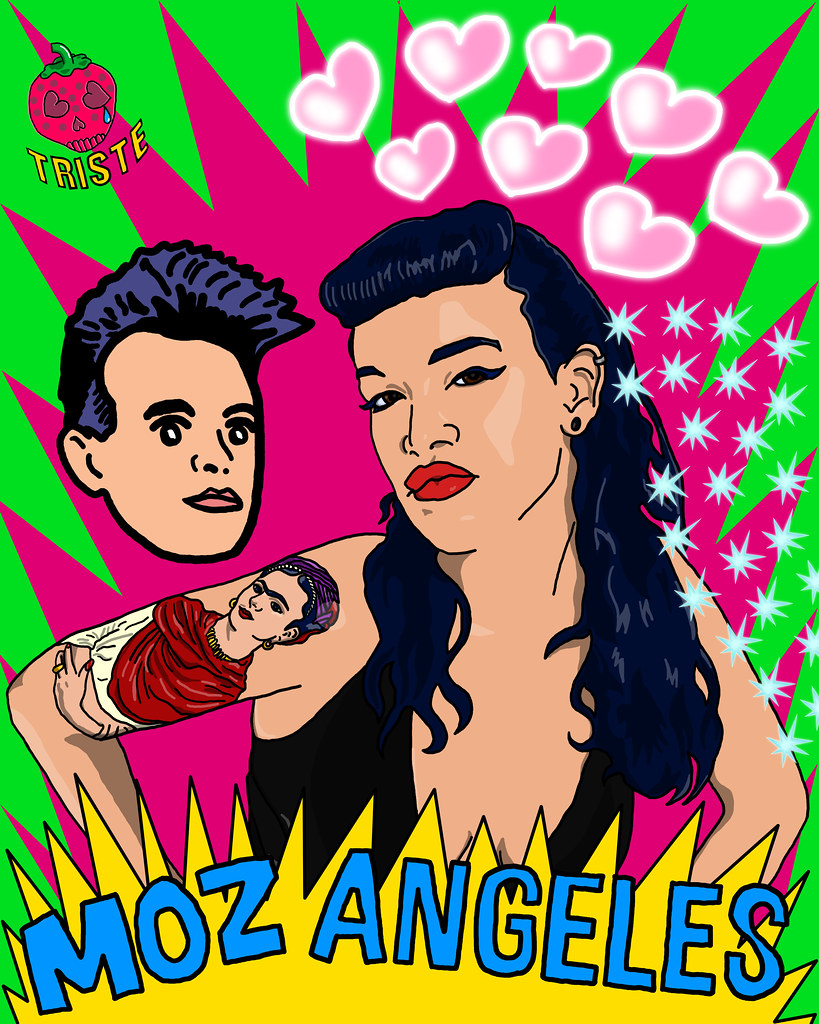 The Latina Hipstera bad-ass Morrissey-lovin’, tuff-girl sexy chica
The Latina Hipstera bad-ass Morrissey-lovin’, tuff-girl sexy chica The Latina Role Modela diploma totin’ intellectual, sexy, social media goddess
The Latina Role Modela diploma totin’ intellectual, sexy, social media goddess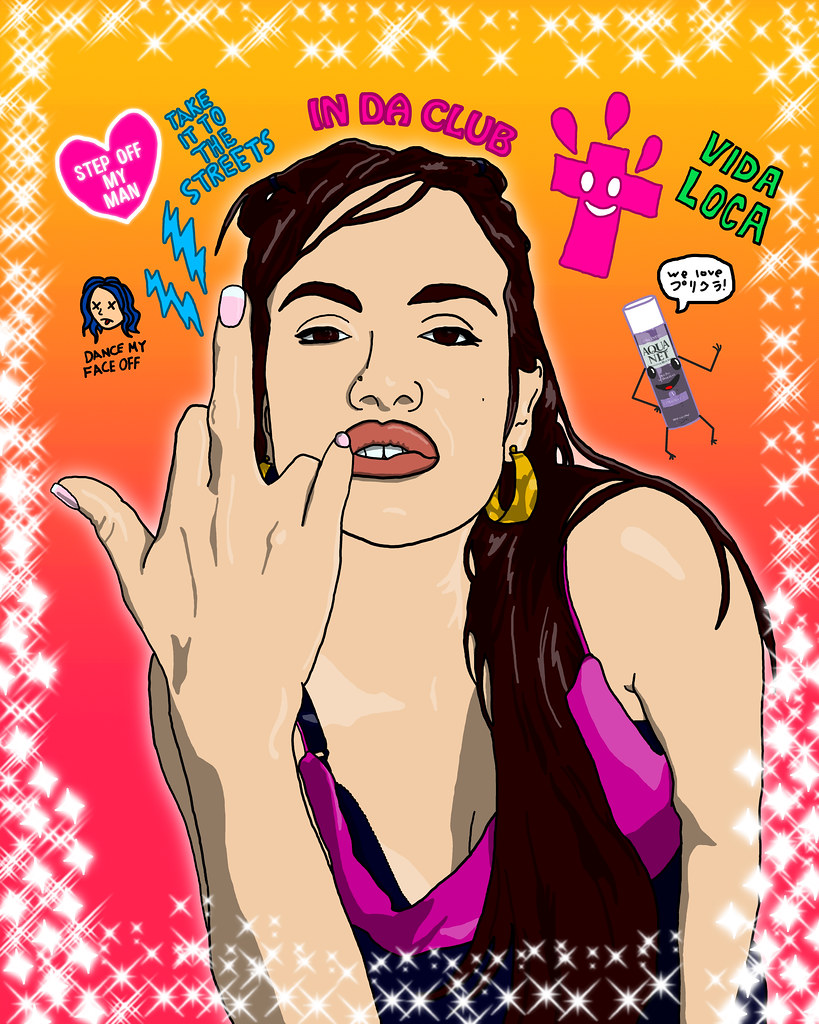 The Homegirla hybridized version of Escobar’s Midwestern Chach and Yañez’s West Coast Chola.In Acciones Plásticas Escobar created a multi-faceted “doll” by assuming the role of designer and distributor, and even posing as the actual doll itself. Each doll was a satirical characterization of some of the many roles that have been projected upon her, and into which she has, at points, inevitably fallen. In conjunction with these images, she developed a short series of low-definition youtube video blogs through which she inhabits the lives of “real women” who have each been visibly defined by societal constructs.Recently, Yañez has been utilizing Japanese photobooths (known as Purikura or “print-club”) as an artist’s tool for creating portraits. These booths are much more common in Japan than their United States counterparts. As a catalyst for creative expression and social interaction they are used primarily by young urban Japanese girls. A standard feature in all Purikura booths allows the user to digitally decorate their portraits after they take them. The options are vast and include wild characters, excessive starbursts of light, pre-made phrases and the option to draw your own text directly on the image. Purikura gives the subjects near-divine powers of self-expression in crafting their own portraits.The two artists who met over the web, decided to bring together Escobar’s highly charged and evocative Acciones Plásticas characters with Yanez’s notorious Chicano graphic-art style and new found obsession with Purikura images, as a way of addressing the construction of Latina identities.Maya posed as The Latina Hipster: a bad-ass Morrissey-lovin’, tuff-girl sexy chica; The Latina Role Model: a diploma totin’ intellectual, sexy, social media goddess; and finally, The Homegirl: a hybridized version of Escobar’s Midwestern Chach (or Chachi Mama) and Yañez’s West Coast Chola. Maya sent digital images to Rio, who in turn drew portraits of her as each of these constructed identities. He approached each portrait with a Purikura sensibility and decorated them each as the characters represented might accessorize themselves. The final series of portraits is the result of negotiating multiple identities and influences. Guatemalan, Jewish, and Chicano sensibilities reflected back through a Japanese Purikura aesthetic. Acciones Plásticas プリクラ challenge and question the thin line between archetype and stereotype. The Purikura elements present the novel signifiers of each social construct represented in the series.This collaboration is the first of many to come as Maya and Rio explore the commonalities and differences of their cultural identities.For more information on Acciones Plásticas プリクラcheck out Rio's blog and stay tuned for guest post by seeNoga aka Carianne Noga on meeting the Chach Homegirl in real life.(video of the Chach featured below)[youtube=http://www.youtube.com/watch?v=Xj3Q42YF40Y]
The Homegirla hybridized version of Escobar’s Midwestern Chach and Yañez’s West Coast Chola.In Acciones Plásticas Escobar created a multi-faceted “doll” by assuming the role of designer and distributor, and even posing as the actual doll itself. Each doll was a satirical characterization of some of the many roles that have been projected upon her, and into which she has, at points, inevitably fallen. In conjunction with these images, she developed a short series of low-definition youtube video blogs through which she inhabits the lives of “real women” who have each been visibly defined by societal constructs.Recently, Yañez has been utilizing Japanese photobooths (known as Purikura or “print-club”) as an artist’s tool for creating portraits. These booths are much more common in Japan than their United States counterparts. As a catalyst for creative expression and social interaction they are used primarily by young urban Japanese girls. A standard feature in all Purikura booths allows the user to digitally decorate their portraits after they take them. The options are vast and include wild characters, excessive starbursts of light, pre-made phrases and the option to draw your own text directly on the image. Purikura gives the subjects near-divine powers of self-expression in crafting their own portraits.The two artists who met over the web, decided to bring together Escobar’s highly charged and evocative Acciones Plásticas characters with Yanez’s notorious Chicano graphic-art style and new found obsession with Purikura images, as a way of addressing the construction of Latina identities.Maya posed as The Latina Hipster: a bad-ass Morrissey-lovin’, tuff-girl sexy chica; The Latina Role Model: a diploma totin’ intellectual, sexy, social media goddess; and finally, The Homegirl: a hybridized version of Escobar’s Midwestern Chach (or Chachi Mama) and Yañez’s West Coast Chola. Maya sent digital images to Rio, who in turn drew portraits of her as each of these constructed identities. He approached each portrait with a Purikura sensibility and decorated them each as the characters represented might accessorize themselves. The final series of portraits is the result of negotiating multiple identities and influences. Guatemalan, Jewish, and Chicano sensibilities reflected back through a Japanese Purikura aesthetic. Acciones Plásticas プリクラ challenge and question the thin line between archetype and stereotype. The Purikura elements present the novel signifiers of each social construct represented in the series.This collaboration is the first of many to come as Maya and Rio explore the commonalities and differences of their cultural identities.For more information on Acciones Plásticas プリクラcheck out Rio's blog and stay tuned for guest post by seeNoga aka Carianne Noga on meeting the Chach Homegirl in real life.(video of the Chach featured below)[youtube=http://www.youtube.com/watch?v=Xj3Q42YF40Y]
Talking About Orchard Street

photo by Julian Voloj
Maya and Gonzalo Escobar create Talking about Orchard Street, a multi-sensory interactive installation that explores the generational transmission of Jewish life through dialog. The father-daughter duo traveled from Chicago to New Haven to conduct interviews with former members and friends of Orchard Street Shul and to record locals’ stories of growing up in New Haven during the 1920s and 30s. These stories of everyday life include tales of flirting on the front steps of the shul, eating herring and kichel, speaking Jewish, finding first jobs, going on first dates, learning bar mitzvah portions, and hearing (or having) loud conversations in the women’s section. In Talking about Orchard Street, visitors are invited to sit in comfortable armchairs, sample herring and kichel, listen to excerpts from interviews and engage in dialog with each other.click here for more information about the Orchard Street Shul Artist Cultural Heritage Project
Orchard Street Artist Cultural Heritage Project
My father and I participated in the Orchard Street Artist Cultural Heritage Project.
During the months of December 2009 and January 2010, The John Slade Ely House Center for Contemporary Art in New Haven, Connecticut will come alive with memories, recollections, and recreations of an important community heritage site, in an innovative group installation designed to both stimulate reflection on the legacies of past generations and engage the public in dreams for the future.The Orchard Street Shul Cultural Heritage Artists Project is an art exhibition, a history lesson, a point of cultural exchange, and meeting place for dreamers, both nostalgic and visionary. Artists, researchers, and scholars have joined together to celebrate an important historic New Haven landmark which was once central to the life of a large Jewish immigrant population in the Oak Street neighborhood.Urban changes in the last 50 years have all but erased evidence illustrating the importance of the Oak Street neighborhood in the lives of the newly arrived immigrants and migrants who populated much of the area now known as the "Oak Street Connector", Route 34. Where some see open space, or a new hospital, or a school, or a parking lot, others with longer memories see shops bustling with activity, voices shouting in Yiddish and Italian, sprinkled with a variety of accents from elsewhere, including near and distant regions within the USA.Contributions to the installation offer a range of approaches. Some artists researched the history of the Orchard Street Shul and its neighborhood, uncovering multiple stories of this community: stories of women working together to aid refugees, stories of hard-working fathers and mothers who dedicated themselves to making a better life for their children, and stories of teenagers who giggled and mingled on the steps of the Shul. Others built on their own experiences, reaching into their hearts to create depictions of the Shul that are evocative of deeper connections with history and community. Still others focused on the issues of urban renewal, making real the shifts in our urban landscape that are difficult to imagine as we visit the site today.Included in the Project are presentations by researchers from Yale University who developed innovative ways to document the building, including virtual reconstructions exploring new digital methods, ground-breaking research by computer scientists that promises to change the ways that cultural heritage sites will be documented in the future. Some contributing artists used this digital data in their creative work.The Orchard Street Shul Cultural Heritage Project is organized by Cynthia Beth Rubin, a New Haven based artist, in collaboration with participating artists and researchers: Nancy Austin, Meg Bloom, DonnaMaria Bruton, Jeanne Criscola, Roslyn Z. Croog, Linda Drazen, Paul Duda, Gonzalo Escobar, Maya Escobar, Alan Falk, Greg Garvey, Shalom Gorewitz, Jaime Kriksciun, Leslie J. Klein, Beth Krensky, Seth Lamberton, Mary Lesser, Lisa Link, David Ottenstein, Bruce Oren, Robert Rattner, Cynthia Beth Rubin, Holly Rushmeier, Janet Shafner, Frank Shifreen, Suzan Shutan, Sharon Siskin, Christina Spiesel, Yona Verwer, Julian Voloj, Laurie Wohl, Chen Xu, and Howard el-Yasin. The group includes artists from California, Florida, Utah, Missouri, Rhode Island, Massachusetts, and New York, who traveled to New Haven to contribute to the project alongside artists from the region.A Project Book is being published in conjunction with the exhibition, including essays by Haisia Diner, the eminent scholar of Jewish immigration history, Walter Cahn, renowned historian of art and and architecture, and Hana Iverson, known for her remarkable multi-media installation "View from the Balcony" that was instrumental in helping attract attention to the renovation project of the Eldridge Street Shul. The book will also feature photographs of the works in the exhibition and memories of the Orchard Street Shul, with commentary by Karen Schiff. The innovative book design is by Criscola Design.The Public is Invited to the Opening Reception for the Participating Artists, on Sunday, December 6, from 12:00 Noon to 5:00 pm. To set the mood for the launch of “The Orchard Street Shul Artists Cultural Heritage Project”, the Joseph Slifka Center for Jewish Life at Yale for Jewish Life at Yale will host a Jazz jam session on December 5 at 7:30, celebrating the swing dance music of 1924 and beyond, when the cornerstone of this Synagogue was put in place in a ceremony attended by Mayor Fitzgerald and much of the entire New Haven community.The John Slade Ely House Center for Contemporary Art is open W-F, 11:00 am to 4:00 pm, and weekends 2:00 pm to 5:00 pm. Schools and other organizations who would like to arrange a group visit outside of regular hours may do so by sending an email to: [email protected].
Nuevos Compañeros: Rio Yañez
My newest partner in crime is the talented, witty, godzilla and pikapika lovin' Chicano artist and curator Rio Yañez. I first came across his Ghetto Frida two years ago, while working on the project Obsessed With Frida Kahlo. Immediately I felt some sort of cosmic connection-not to Ghetto Frida- but to her creator. And then to make matters worse better, I found out that he is the son of one my biggest heroes- Yolanda Lopez!There was really no option other than collaboration. It was fate.Last month we finally initiated our long distance partnership through a tweet. Since then we have been communicating through TwitPic, Facebook, YouTube, phone calls and texts, and of course mutual shouts in interviews on the blogosphere (mine to Rio & Rio's to me.)Here are a few examples of Rio's recent work:
"I’ve been twittering for about a week now at http://twitter.com/rioyanez. I signed up as a way to contact Amber Rose after she started writing and posting about the portrait I created of her. I have to say, the most exciting aspect of twitter is the way people distribute images. The short urls for twitpics that often pop up on tweets evoke a sense of curiosity in me; more so than the many thumbnails that can be found on facebook. I think the lack of a thumbnail is more alluring and it forces you to chose to see the image or not, there’s no middle ground of a provided preview." (from his blog)
"Artist Curator Rachel-Anne Palacios flanked by Zitlalix and I. I created this portrait to thank Rachel for including me in the recent Frida exhibit she curated and to join the many artists who are on display on the walls of her apartment" (from flickr)
These images represent my first foray into my Raza Zombies series. They were inspired by the single best mainstream comic book of the 21st century: Marvel Zombies. Marvel Zombies re-imagines classic superheroes as flesh eating zombies. After reading it I felt compelled to do some zombie transformations on a few of my own personal heroes. More to come. (from flickr)[youtube=http://www.youtube.com/watch?v=1AhRQrJ7ePg]
Video of Gomez Peña setting the record straight for Rio regarding his Facebook presence.
[youtube=http://www.youtube.com/watch?v=QycIf6uKRd0]
Rio's Ghetto Frida Mural in the Mission District
stay tuned for more...
take a picture of me for my myspace
In October of 2006 my rabbi started blogging. While trying to comment on one of his posts, I accidentally registered my own blog. Within hours of posting a comment, my name began appearing in Google searches. I was now linked to the post I had commented on, previous posts my rabbi had written, comments left by other users and the posts they had written elsewhere within the blogosphere. The rapidity with which I was branded, not only by my own online activity, but also by the online activity of others, seemed incomprehensible.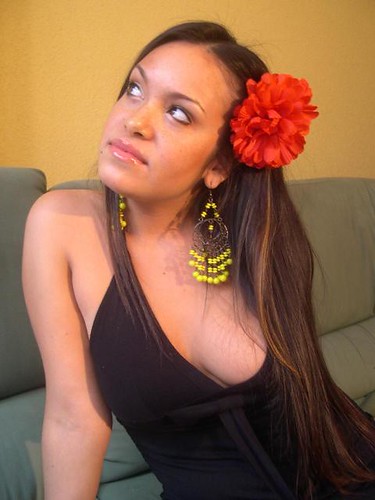 I thought about this phenomenon in relationship to, the images that my friends and I had posted on Myspace throughout that year. I unknowingly went from being slightly annoyed and simultaneously amused by the phrase "take a picture of me for my Myspace", to it becoming completely natural and almost organic to document every moment, every outing, every time my friends and I put on make up, and to take pictures for Myspace. I saw this behavior even further exaggerated in the high school students I was student teaching. Their conversations were dominated with events that had transpired on Myspace, and when they were not talking about Myspace they were taking pictures for Myspace.When we talked about the factors that contributed to the construction of their individual and collective identities, my students were quick to bring up their style of dress, group of friends, the neighborhood they lived in, and the way they spoke. Yet not a single student referenced their online activity, the pictures they posted, the groups they joined, the comments they left on each others pages. I wondered why it was, that they were so aware of and adept at reflecting upon their experiences in the material offline world, but failed to mention the social network that played such a major role in their day-to-day lives.DECONSTRUCTING PERSONAL IDENTITY
I thought about this phenomenon in relationship to, the images that my friends and I had posted on Myspace throughout that year. I unknowingly went from being slightly annoyed and simultaneously amused by the phrase "take a picture of me for my Myspace", to it becoming completely natural and almost organic to document every moment, every outing, every time my friends and I put on make up, and to take pictures for Myspace. I saw this behavior even further exaggerated in the high school students I was student teaching. Their conversations were dominated with events that had transpired on Myspace, and when they were not talking about Myspace they were taking pictures for Myspace.When we talked about the factors that contributed to the construction of their individual and collective identities, my students were quick to bring up their style of dress, group of friends, the neighborhood they lived in, and the way they spoke. Yet not a single student referenced their online activity, the pictures they posted, the groups they joined, the comments they left on each others pages. I wondered why it was, that they were so aware of and adept at reflecting upon their experiences in the material offline world, but failed to mention the social network that played such a major role in their day-to-day lives.DECONSTRUCTING PERSONAL IDENTITY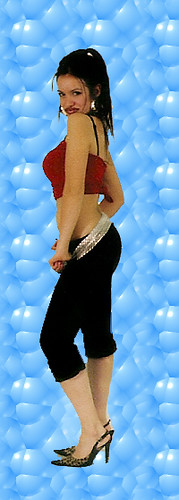 (today) I am referring to myself as a performance artist, Internet curator, and editor. I create and (concurrently) perform multiple online identities, by sampling from different representations of existing cultural discourses. I fragment my personal experiences and invite others to join in, and modify and regroup those fragments. By doing this I hope to share the process through which I deconstruct and reconstruct my individual conception of self, so that others can do the same in their lives.In the series Acciones Plásticas I performed representations of five constructed characters: a religious Jewish woman, a spoiled Jewish girl, a ghetto Latina, a sexy Latina professor, and a Mayan woman. I created low quality YouTube video blogs for four of the characters, the Mayan woman did not have a video, as she would not have had access to YouTube technologies. The videos were strategically placed on popular social networking sites, including YouTube and MySpace. The layout of YouTube contextualized the videos and framed them with user comments and similarly tagged user content. Jewish Girls was picked up by a popular left-wing Jewish blogging site Jewschool, and soon entered the Jewish Blogosphere where it was referred to as the JAP. This repositioning shifted the focus from the portrayal of multiple interwoven identities to a depiction of the Jewish American Princess. The JAP became how people knew my work, validating me while simultaneously conflating my identity with that of this particular character.
(today) I am referring to myself as a performance artist, Internet curator, and editor. I create and (concurrently) perform multiple online identities, by sampling from different representations of existing cultural discourses. I fragment my personal experiences and invite others to join in, and modify and regroup those fragments. By doing this I hope to share the process through which I deconstruct and reconstruct my individual conception of self, so that others can do the same in their lives.In the series Acciones Plásticas I performed representations of five constructed characters: a religious Jewish woman, a spoiled Jewish girl, a ghetto Latina, a sexy Latina professor, and a Mayan woman. I created low quality YouTube video blogs for four of the characters, the Mayan woman did not have a video, as she would not have had access to YouTube technologies. The videos were strategically placed on popular social networking sites, including YouTube and MySpace. The layout of YouTube contextualized the videos and framed them with user comments and similarly tagged user content. Jewish Girls was picked up by a popular left-wing Jewish blogging site Jewschool, and soon entered the Jewish Blogosphere where it was referred to as the JAP. This repositioning shifted the focus from the portrayal of multiple interwoven identities to a depiction of the Jewish American Princess. The JAP became how people knew my work, validating me while simultaneously conflating my identity with that of this particular character.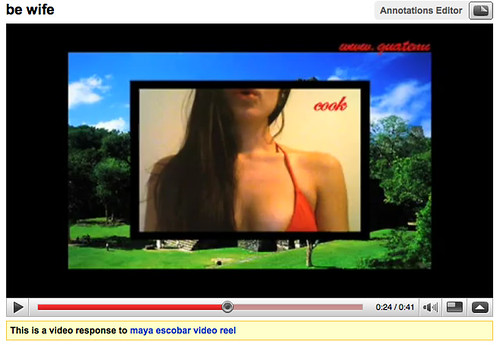 One of the strategies that I employed to counteract idea of "me as The JAP" was to group videos from the series Acciones Plásticas together with three other Youtube videos in a video reel of my work. The first video in the reel, el es frida kahlo is me dressed as Frida Kahlo where I violently scream I am Frida Kahlo! In second video Be Wife, I wear a bright red bikini top in front of an image of a Mayan temple in Tikal. Traditional Guatemalan marimba music plays in the background, while red text scrolls across the top reading Guatemala's finest export. The third video Que Sencilla, features me as a little girl, who is being coaxed by an off-camera male voice to perform a dance for the camera.Someone who is expecting to see a Jewish American Princess, is instead greeted with an enraged
One of the strategies that I employed to counteract idea of "me as The JAP" was to group videos from the series Acciones Plásticas together with three other Youtube videos in a video reel of my work. The first video in the reel, el es frida kahlo is me dressed as Frida Kahlo where I violently scream I am Frida Kahlo! In second video Be Wife, I wear a bright red bikini top in front of an image of a Mayan temple in Tikal. Traditional Guatemalan marimba music plays in the background, while red text scrolls across the top reading Guatemala's finest export. The third video Que Sencilla, features me as a little girl, who is being coaxed by an off-camera male voice to perform a dance for the camera.Someone who is expecting to see a Jewish American Princess, is instead greeted with an enraged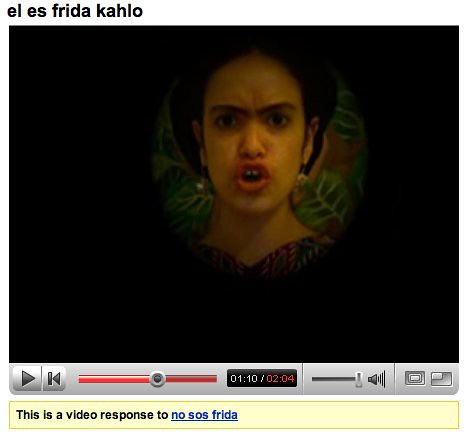 Latina artist, trying to fight the stigma of being associated with Frida Kahlo. My inclusion of these additional videos was to show the multidimensionality of the five characters initially presented in Acciones Plásticas. The Mayan women does not have her own YouTube video, but with the addition of the Be Wife video, her absence is felt even greater. The face of Guatemala in these videos, is the chest of a mail order bride. Another example can be seen within the four original videos themselves. With the grouping of the ghetto latina with the sexy latina professor, vast cultural and class difference can be seen between the two representations of Latina women. Put together with el es frida kahlo and Be Wife, there are suddenly five Latina performers all acting on one stage.
Latina artist, trying to fight the stigma of being associated with Frida Kahlo. My inclusion of these additional videos was to show the multidimensionality of the five characters initially presented in Acciones Plásticas. The Mayan women does not have her own YouTube video, but with the addition of the Be Wife video, her absence is felt even greater. The face of Guatemala in these videos, is the chest of a mail order bride. Another example can be seen within the four original videos themselves. With the grouping of the ghetto latina with the sexy latina professor, vast cultural and class difference can be seen between the two representations of Latina women. Put together with el es frida kahlo and Be Wife, there are suddenly five Latina performers all acting on one stage.
Jewish Girls Youtube Comments
Jewish Girls from the series Acciones Plásticas
[youtube=http://www.youtube.com/watch?v=GBjBN0ftcP0]Responses to Jewish Girls
[youtube=http://www.youtube.com/watch?v=PQphBV2Q0ZE]
Berlin's Eruv Video
[youtube=http://www.youtube.com/watch?v=bGjJhIFUNGA][youtube=http://www.youtube.com/watch?v=CycyYiY933A][youtube=http://www.youtube.com/watch?v=yCM4rrhbj5U]click here to visit website
